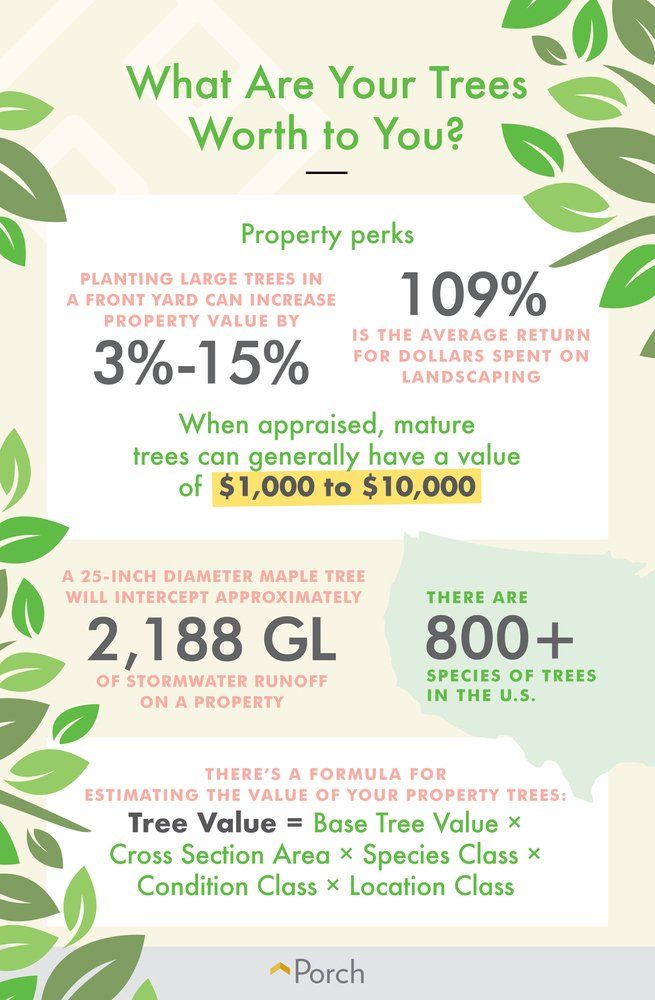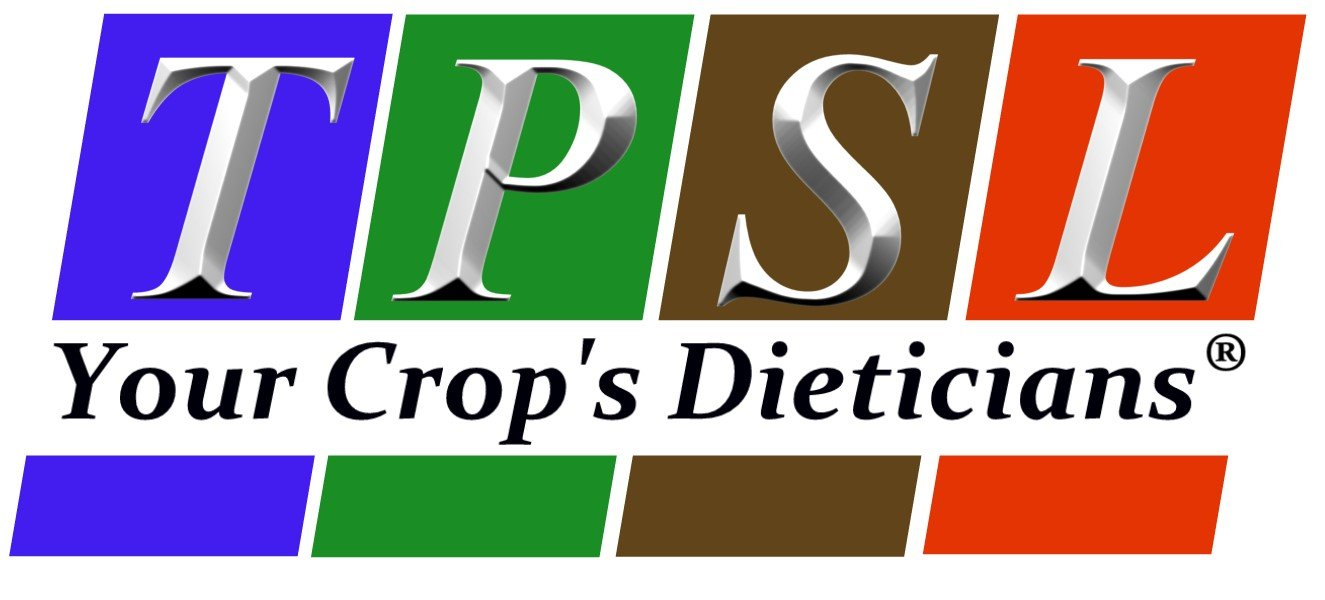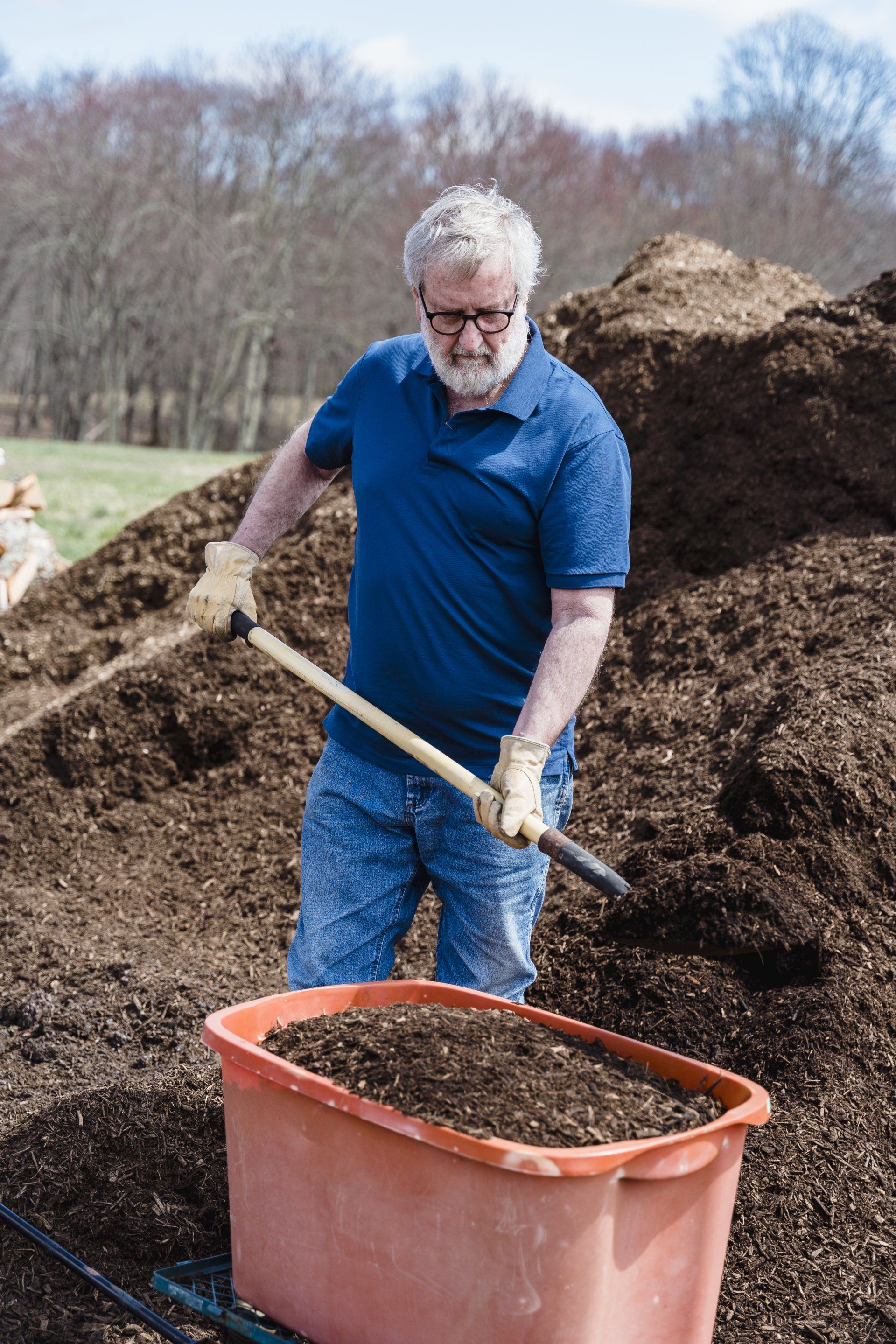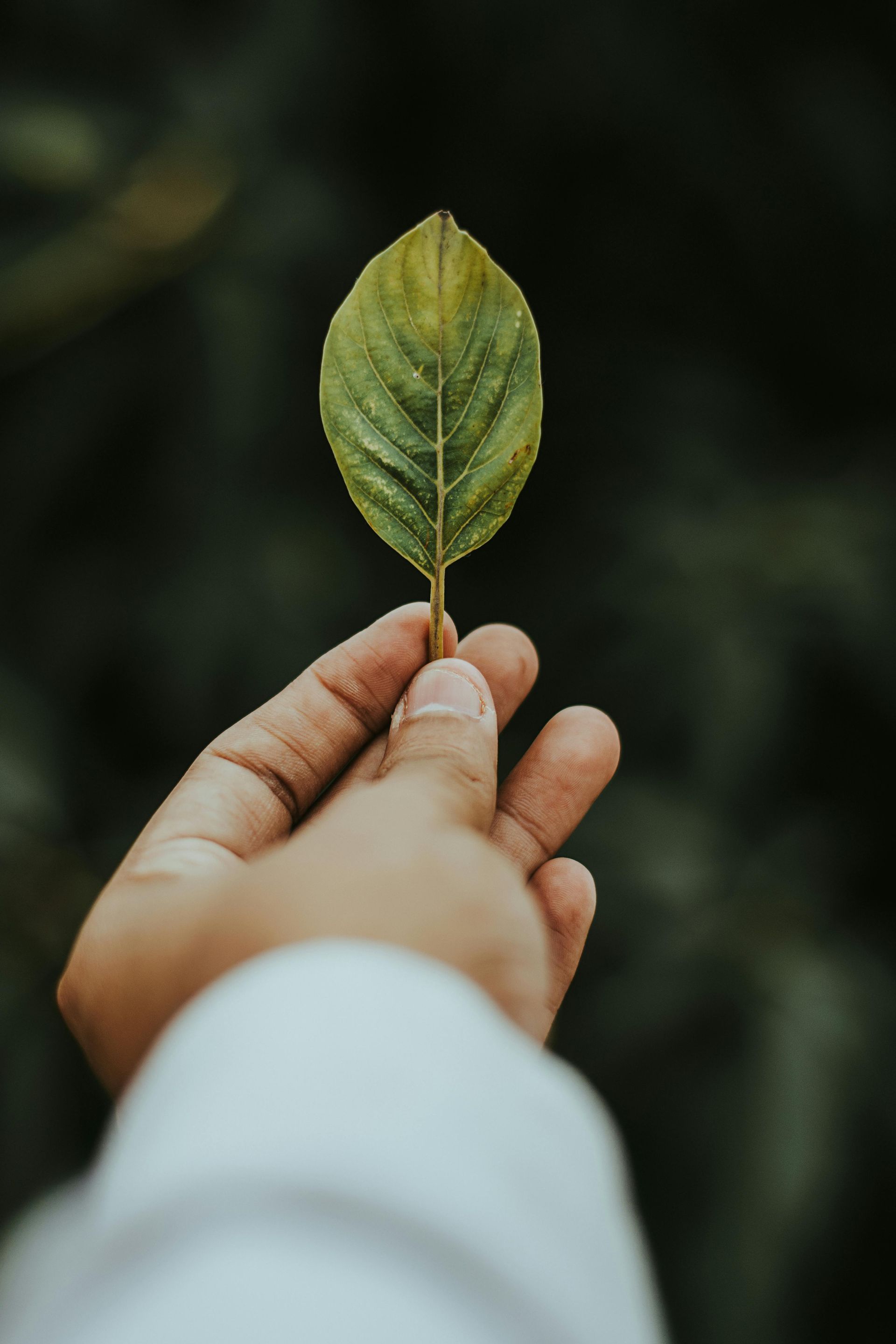How Much Are Your Trees Really Worth?
Learn just how much benefit your trees are adding to your property.

Everyone knows trees are valuable, but did you know you can actually calculate their specific added value to your property? If you’ve ever had to purchase a tree for your yard, you know that it can be an expensive investment, even for a young tree. And maintaining this tree can also be costly, such as leaf removal or tree trimming. Having mature trees in your yard or property is usually seen as value commodity: trees provide necessary shade for houses, can act as a screen for unwanted noise or views, protect slopes from erosion, and are pretty to look at. But they can block a desirable view, create a leafy mess, cause damage to the home from broken limbs, and roots can damage driveways or underground pipes. So, should you be planting more trees in your yard or paying for their removal?
Overall benefits of trees
To get to the bottom of the question, “how much are my trees worth,” let’s take a look at the Tree Benefit Calculator. With just a few pieces of information, this website can tell you just how much value your trees are adding to your property. For example, in my climate zone, a 25-inch diameter Big Leaf Maple tree provides overall benefits of $196.00 per year to my property. Other species, and their size, may lead to a larger or smaller cost-benefit. A similarly-sized Douglas Fir provides an annual benefit of $232, with varying benefits to the property value, energy savings, and CO2 absorption. Overall, all trees benefit our environment, and it’s always in our best interest to maintain them. Let’s take a look at the specific cost benefits of owning trees.
Stormwater absorption by trees
The calculator estimates that within the course of one year, this 25-inch diameter maple tree will intercept 2,188 gallons of stormwater runoff on my property. The image below shows just how much a tree does for water runoff, important for both wet climates that see continual rain as well as semi-dry climates that occasionally see flash-flood type of conditions. When rain falls, leaves and branches slow down the flow of water to the ground. Roots absorb water and also act as a filter for water running into our waterways. As our towns and cities become covered with more concrete and asphalt, it’s incredibly important that trees are planted to help filter water before it ends up in our rivers and lakes. And if you’ve ever had a neighbor cut down a lot of trees, then see how your property fills with water during a rainstorm; you can immediately see the impact that those roots had in absorbing water. In fact, property flooding isn’t necessarily due to too much water; it’s too much water with too few trees to absorb the excess.
Property value increases with trees
The presence of trees (or lack thereof) can significantly impact your property value. Using the same data, Tree Benefits calculates that this single maple tree will raise my property value by $120 this year. Much of this calculation is based on Leaf Surface Area (LSA) models, “that’s a researcher’s way of saying that a home with more trees (and more LSA) tends to have a higher value than one with fewer trees (and lower LSA),” according to their website. The higher the LSA, the higher the property value. The Pacific Northwest Research Station recently conducted a study of just how much trees raise property values in the city of Portland, Oregon. Considering the annual maintenance cost that cities spend on trees, understanding the economic value of these trees is important. In fact, this study found that the presence of trees along the street increased the sale prices of houses in east Portland neighborhoods by an average of $8,870 and reduced time on the market by an average of 1.7 days. Trees in front of the house also increased the home’s sale price by an average of $7,130. “Citywide, street trees add $1.1 billion to Portland’s property value, or $45 million a year. Annual maintenance costs of $4.6 million are a small fraction of the trees’ value and are mostly borne by property owners.”*
Energy benefits of trees
Trees can provide necessary shade for houses, which creates a cooler interior environment. My example of the single maple tree is expected to help me conserve 92 Kilowatt/hours of electricity this year. The illustration below shows the three primary ways trees can help reduce the amount of electricity or natural gas homeowners spend heating or cooling their homes. Trees provide shading for a house, making the house cooler and can reduce the amount of heat absorbed by the structure.
Evapotranspiration, which is the process of liquid water converting to water vapor and subsequently cooling the air, helps create a slightly lower air temperature. Additionally, trees and tree canopies can slow down the surrounding wind, reducing the amount of heat lost through the house (like windows).
Air quality improves with trees
Most of us are aware that trees can provide oxygen to our environment as well as absorb carbon dioxide, creating a better air quality. Air pollution is a health hazard for many people globally, leading to asthma, cancer, or serious respiratory diseases. Trees can absorb numerous toxic chemicals like sulfur dioxide, nitrogen dioxide, and ozone. Trees can also absorb tiny particles like dust, ash, and smoke, which can get into our homes and lungs. Trees can lower the overall air temperature, reduce ozone production, and release oxygen into the air. The destruction of forests negatively impacts our overall air quality, but planting even one tree on your property can positively impact your surrounding environment and air quality.
Carbon dioxide absorption by trees
Carbon dioxide is released into our environment in multiple ways, but the most common are vehicles and other forms of transportation. My single maple tree is expected to reduce atmospheric carbon by 694 pounds this year. In comparison, an average midsize car can generate about 11,000 pounds of CO2 per year. So although one tree doesn’t cut out a person’s entire carbon footprint, planting trees in your yard and helping to preserve trees in your neighborhood can significantly help absorb CO2 in your environment. According to Tree Benefits, trees sequester CO2 in their roots, trunks, stems, and leaves as they grow. Additionally, trees can help reduce the need for heating and cooling, leading to lower CO2 production.
Types of Trees and Their Maintenance
Most Common Types of Trees to Grow
There are more than 800 species of trees in the U.S. So, what types of trees should you select for your landscape? While you might be inclined to choose trees that are considered most advantageous for supporting (or enhancing) property value, you might also simply choose trees that you find attractive. However, be sure that you’re considering each tree type’s maintenance needs and growing requirements. Be sure that you are aware of the tree’s growing preferences before you purchase.
Some of the most common types of trees that homeowners choose to plant include:
- Red Maple
- Douglas Fir
- White Oak
- Flowering Dogwood
- Birch
- Aspen
- Cherry
- Cedar
- Hickory
- Cypress
Before you go tree shopping, do some research. Decide if you want to plant a flowering tree, fruit tree, conifers, or deciduous trees. Also, consider how each tree will appear throughout the year. You might want to choose a tree to add more winter interest to your landscape. In that case, birch and fir trees offer loads of visual appeal.
Low-Maintenance Trees for Your Backyard
Many of the most picturesque trees are decidedly high maintenance. Magnolia trees, for example, are among the loveliest spring bloomers, but they definitely leave a mess as the flowers fall to the ground. Other trees might require more regular pruning to ensure good health. Some trees are more robust than others and require less care from homeowners. Once you choose a tree, be sure to research its maintenance requirements so that you can decide if it’s really a planting you are willing to care for.
Most Suitable Trees by Region
Many southern tree species simply don’t take well to northern climates—and vice versa. That’s why you’ll want to plant trees that are known to grow well in your zone. The Arbor Day Foundation features a helpful tool that’s ideal for choosing the best trees for your region. When talking about planting zones, we’re really referring to the USDA Plant Hardiness Zone Map. This reference will help you choose plantings—trees, shrubs, flowers—that are likely to grow well in a particular region.
The continental United States includes zones 3-10. Alaska and Hawaii obviously feature different growing conditions that we’ll address in a bit. If you live in the following zones, you might want to consider planting some of our included examples:
Zone 3 (includes the northern portions of northern states like Wisconsin and Montana)
- Amur Maple
- Norway Spruce
- Cherry Birch
- Sugar Maple
- European Mountain Ash
Zone 4 (includes northern states like North and South Dakota, Minnesota, Wyoming)
- Juniper
- Dwarf Alberta Spruce
- Eastern Redbud
- Sugar Maple
Zone 5 (northern sections of Illinois, Indiana, and states like New York, Iowa, Nebraska)
- Virginia Pine
- White Pine
- Red Maple
- Tulip Poplar
- Northern Red Oak
- Ginkgo Biloba
Zone 6 (includes states like Kentucky, Kansas, Missouri, Oregon)
- White Dogwood Tree
- American Sycamore
- Southern Magnolia
- Bald Cypress
- Crepe Myrtle
Zone 7 (includes states such as Arkansas, North Carolina, the northern part of Texas)
- Cherry Plum
- White Dogwood Tree
- Murray Cypress
- Sweet bay Magnolia
- Weeping Cherry
Zone 8 (includes states such as Georgia, South Carolina, Mississippi)
- Weeping Willow
- Sassafras
- Flowering Cherry
- Crepe Myrtle
- Honey Locust
- Leyland Cypress
- Pecan
Zone 9 (includes mid-to-northern sections of Florida and southern sections of Texas and Louisiana)
- Windmill Palm
- Holly
- Flowering Dogwood
- Black Walnut
- Italian Cypress
- Alta Southern Magnolia
Zone 10 (includes the southern section of Florida)
- Jacaranda
- Banana Tree
- Italian Cypress
- Pineapple Guava
Best Trees to Grow in Alaska
- Paper Birch
- Quaking Aspen
- Crabapple
- Black Spruce
- Balsam Poplar
Best Trees to Grow in Hawaii
- Banana Tree
- Jacaranda
- Coconut
- Eucalyptus Tree
- Breadfruit Tree
Most Expensive Trees to Grow
If you’re interested in investing in an expensive tree that will likely add value to your landscape, some trees you might consider are:
- Flowering Dogwood
- Heritage Fruit Trees
- Black Walnut
- Hybrid Chestnut
- Willow Tree
- Japanese Maple
Soil Chemistry and How to Test Yours
When choosing trees and other plantings for your landscape and garden, you always want to consider your soil’s chemistry. You can actually purchase soil testing kits at area garden centers, especially at home improvement centers that contain gardening sections. A soil test will tell you the pH of your soil so that you can select a tree that’s likely to thrive in your particular setting.
Soil tests can also help you determine how much organic matter is contained in your soil as well as nutrient content. That’s also important as you may need to amend the soil to ensure that your new planting has the nutrients and organic matter required to thrive.
Want to learn more about the benefit of trees? Check out the National Tree Benefit Calculator.
Reposted from: https://porch.com/advice/much-trees-really-worth



